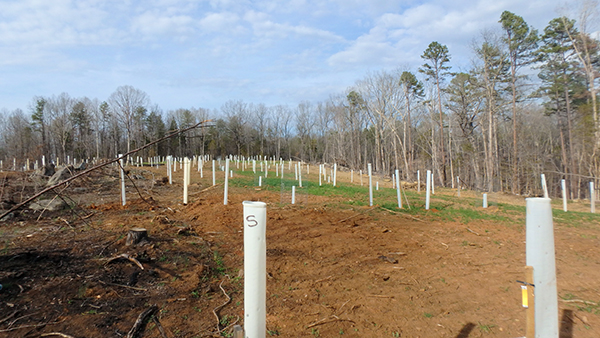Whitetail deer love to eat the leaves and branches of small chestnut trees. Other smaller nut-eating predators like to ingest the planted seeds. Several protection methods have been tried. The favored method is a short tube (18-24 inches) and a wire cage. The tube and cage method is more costly and time consuming than, for example, five-foot tall vented plastic tree tubes. The tall tubing method has a bad reputation with many growers because trees have problems at around two years of age. However, anecdotal evidence shows that, after approximately seven years, the trees may recover from these ill effects.
On March 27, Fred Clodfelter and family, with the help of Ed Schwartzman, Southern Regional Science Coordinator, and Carolinas Chapter volunteers, planted 184 Meadowview B3F3 chestnut seeds from six different Graves lines in a recently timbered and prescribed burned three-acre field. The planting will test how different tree shelters affect deer browse and tree health. It will also will compare the ease and efficiency of installing the three different tree protection techniques. The treatments used were: (a) closed 5′ plastic tubes, (b) 5′ plastic tubes that can be opened as seedlings grow, and (c) two-foot tall tubes with four-foot tall wire fence cages centered over the planted seed. Clodfelter will monitor and report on the growth of the chestnut seedlings and the effectiveness of the shelters. The following weekend, Clodfelter’s family planted an additional 80 chestnut seeds in four forest openings. A mixture of tubes and cage treatments were used for these plantings as well.
Through the Forest Stewardship Program, Clodfelter, a chestnut grower for the Carolinas Chapter, developed a management plan for his 510-acre family farm that includes improvements to timber, wildlife, and soil & water quality. The Clodfelter Farm borders the Uwharrie National Forest in the southwest portion of Randolph County, North Carolina. The farm has been in Clodfelter’s family for more than 150 years.

The planting site with tree shelters installed.
